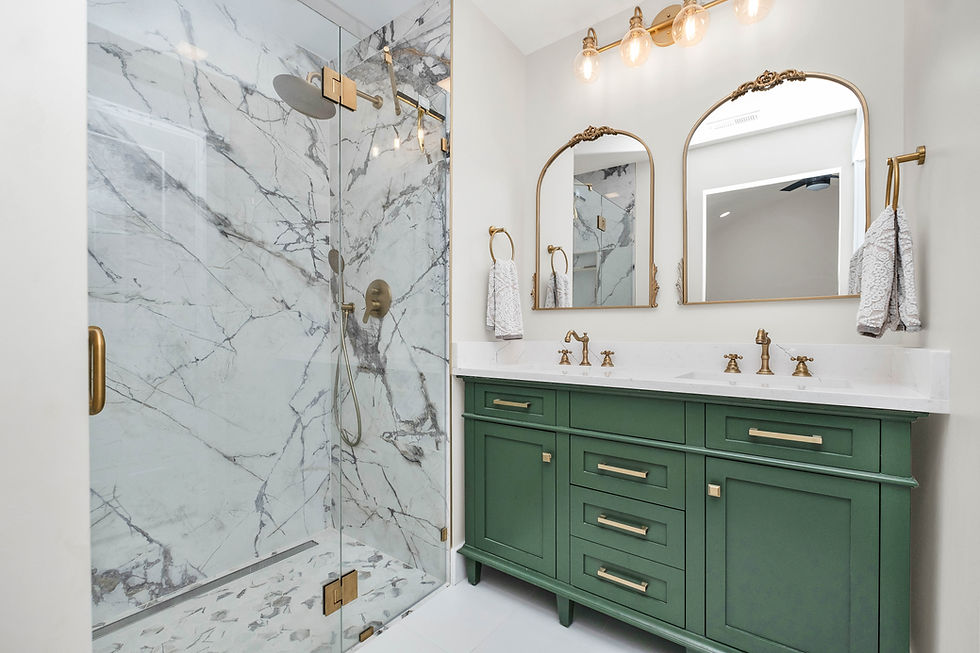Think Like a Designer: Achieve Luxury Looks for Less
- Marieke Rijksen

- Jul 25
- 3 min read
Creating a high-end home doesn’t have to mean maxing out your budget. In fact, the most sophisticated interiors often come down to clever planning rather than eye-watering spending.
Designers know that thoughtful choices — from the proportions of a window to the finish on a humble door handle — can achieve a polished, luxurious feel without the luxury price tag.
Let’s explore how you can think like a designer and create a high-end look with smart decisions, not a runaway budget.

The Power of Thoughtful Planning
A sense of luxury begins on the drawing board. When you plan your layout and details with care, even standard products can look bespoke.
Aligning the sightlines of your windows with your flooring pattern, for example, immediately feels considered and elegant. Similarly, basic interior doors can feel far more special if you invest in beautiful handles and hinges.
Luxury is not necessarily about rare materials — it is about deliberate design, proportion, and balance.
Always begin with a clear plan: where do you want to make an impact, and where can you stay simple? This will help you avoid expensive mistakes later.
Luxury is not necessarily about rare materials — it is about deliberate design, proportion, and balance.

Architectural Features: Save Without Sacrificing Style
Statement architecture often carries a hefty price tag. Curved, arched, or angled windows are visually dramatic but complicated to manufacture, install, and maintain.
If what you really want is an expansive view, a large rectangular window with a slim, elegant frame can offer the same wow-factor with far less cost and complexity.
Likewise, pivot doors in steel or bespoke timber are breathtaking but expensive. A simpler pivot hinge on a standard-size timber door finished in a striking colour can create a similar sense of grandeur at a more modest price.
Even double-height feature glazing, which looks spectacular, can be reimagined as stacked floor-to-ceiling windows with a discreet mullion. The design language is the same, but the bill is far smaller.

Material Alternatives with a Luxury Finish
Beautiful materials elevate a space, but they don’t have to be the rarest or most costly.
Porcelain tiles, for example, can convincingly mimic natural stone at a fraction of the cost and with easier upkeep.

Concrete-look porcelain is far more practical than a poured concrete floor but achieves the same contemporary mood.
Crittall-style steel windows are gorgeous but expensive and prone to heat loss; slim, powder-coated aluminium windows can deliver the same aesthetic with far better insulation and a friendlier price.
Likewise, timber slat walls are popular in luxury interiors, but veneered MDF slats or even painted timber alternatives give a nearly identical effect while keeping the budget in check.

Design-Led Value: Features That Punch Above Their Price
A high-end look is rarely about splashing cash on every element. Designers know where to focus.
A good example is using affordable kitchen cabinet carcasses from IKEA, then pairing them with custom doors from suppliers like Plykea or Husk. You get a one-of-a-kind finish on a mass-produced foundation.
Similarly, basic MDF panelling painted in a rich heritage colour can rival expensive bespoke wall panelling.
Or consider a simple staircase elevated with a striking balustrade or carefully chosen handrail. These kinds of swaps deliver a huge visual impact without spiralling costs.

Think Like a Designer: Prioritise Where to Spend
One of the best ways to stretch your budget is to identify the “hero” features in each space. Splurge on these, and simplify everything else.
For instance, invest in a stunning worktop or high-quality taps, but save money with flat-panel cabinet doors and affordable appliances.

Good designers will often focus spending on handles, switches, or statement light fittings while keeping the background elements restrained and cost-effective.
Clever lighting layouts with standard recessed spots plus one or two dramatic pendants can also create a luxury mood without luxury prices.
Small Details, Big Impact
Finishing details can make or break the look of a home. Coordinating switches and sockets, matching paint finishes, or running the same flooring through multiple rooms all contribute to a sophisticated and calm atmosphere.
Minimal window dressings that frame — rather than hide — your glazing can showcase a great view or well-planned windows, reinforcing that high-end feel.

These details are often affordable but require thought. And that’s the true secret: a well-planned space, however modest the budget, will always read as more luxurious than an expensive space built without care.
Conclusion
A luxury home is as much about design thinking as it is about money.
A luxury home is as much about design thinking as it is about money. By planning carefully, prioritising where you splurge, and making thoughtful choices on materials and features, you can achieve a sophisticated, high-end look for far less than you might think.
After all, the real mark of luxury is not just price — it is intention.




